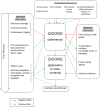Group Qigong for Adolescent Inpatients with Anorexia Nervosa: Incentives and Barriers
- PMID: 28152083
- PMCID: PMC5289494
- DOI: 10.1371/journal.pone.0170885
Group Qigong for Adolescent Inpatients with Anorexia Nervosa: Incentives and Barriers
Abstract
Background: Qigong is a mind-body intervention focusing on interoceptive awareness that appears to be a promising approach in anorexia nervosa (AN). In 2008, as part of our multidimensional treatment program for adolescent inpatients with AN, we began a weekly qigong workshop that turned out to be popular among our adolescent patients. Moreover psychiatrists perceived clinical benefits that deserved further exploration.
Methods and findings: A qualitative study therefore sought to obtain a deeper understanding of how young patients with severe AN experience qigong and to determine the incentives and barriers to adherence to qigong, to understanding its meaning, and to applying it in other contexts. Data were collected through 16 individual semi-structured face-to-face interviews and analyzed with the interpretative phenomenological analysis method. Eleven themes emerged from the analysis, categorized in 3 superordinate themes describing the incentives and barriers related to the patients themselves (individual dimension), to others (relational dimension), and to the setting (organizational dimension). Individual dimensions associated with AN (such as excessive exercise and mind-body cleavage) may curb adherence, whereas relational and organizational dimensions appear to provide incentives to join the activity in the first place but may also limit its post-discharge continuation. Once barriers are overcome, patients reported positive effects: satisfaction associated with relaxation and with the experience of mind-body integration.
Conclusions: Qigong appears to be an interesting therapeutic tool that may potentiate psychotherapy and contribute to the recovery process of patients with AN. Further analysis of the best time window for initiating qigong and of its place in overall management might help to overcome some of the barriers, limit the risks, and maximize its benefits.
Conflict of interest statement
The authors have declared that no competing interests exist.
Figures
Similar articles
-
Minding the adolescent in family-based inpatient treatment for anorexia nervosa: a qualitative study of former inpatients' views on treatment collaboration and staff behaviors.BMC Psychol. 2019 Nov 14;7(1):72. doi: 10.1186/s40359-019-0348-2. BMC Psychol. 2019. PMID: 31727151 Free PMC article.
-
Patients' perspective of a group intervention for perfectionism in anorexia nervosa: A qualitative study.J Health Psychol. 2018 Oct;23(12):1521-1532. doi: 10.1177/1359105316660183. Epub 2016 Jul 28. J Health Psychol. 2018. PMID: 27473160
-
'Learning to live your life again': An interpretative phenomenological analysis of weblogs documenting the inside experience of recovering from anorexia nervosa.J Health Psychol. 2018 Sep;23(10):1287-1298. doi: 10.1177/1359105316651710. Epub 2016 Jun 9. J Health Psychol. 2018. PMID: 27287602
-
Adolescents with anorexia nervosa have their say: a review of qualitative studies on treatment and recovery from anorexia nervosa.Eur Eat Disord Rev. 2013 Sep;21(5):352-60. doi: 10.1002/erv.2239. Epub 2013 Jun 13. Eur Eat Disord Rev. 2013. PMID: 23765431 Review.
-
[Group therapy in anorexia nervosa (apropos of a literature review)].Psychiatr Enfant. 1991;34(1):285-302. Psychiatr Enfant. 1991. PMID: 1946804 Review. French.
Cited by
-
The therapeutic effects of qigong in patients with chronic obstructive pulmonary disease in the stable stage: a meta-analysis.BMC Complement Altern Med. 2019 Sep 4;19(1):239. doi: 10.1186/s12906-019-2639-9. BMC Complement Altern Med. 2019. PMID: 31484521 Free PMC article.
-
The Fitter I Am, the Larger I Feel-The Vicious Circle of Physical Exercise in Anorexia Nervosa.Nutrients. 2022 Oct 26;14(21):4507. doi: 10.3390/nu14214507. Nutrients. 2022. PMID: 36364769 Free PMC article.
-
Perception of Paternal Postpartum Depression among Healthcare Professionals: A Qualitative Study.Healthcare (Basel). 2023 Dec 28;12(1):68. doi: 10.3390/healthcare12010068. Healthcare (Basel). 2023. PMID: 38200974 Free PMC article.
-
Perspectives of general psychiatric inpatient care for persons with anorexia nervosa: an integrative literature review.BMJ Open. 2025 May 15;15(5):e098772. doi: 10.1136/bmjopen-2025-098772. BMJ Open. 2025. PMID: 40379342 Free PMC article. Review.
-
Psychopathology, Body Image and Quality of Life in Female Children and Adolescents With Anorexia Nervosa: A Pilot Study on the Acceptability of a Pilates Program.Front Psychiatry. 2020 Oct 30;11:503274. doi: 10.3389/fpsyt.2020.503274. eCollection 2020. Front Psychiatry. 2020. PMID: 33192640 Free PMC article.
References
-
- Yuan C-S. Traditional Chinese Medicine. CRC Press; 2011.
MeSH terms
LinkOut - more resources
Full Text Sources
Other Literature Sources


